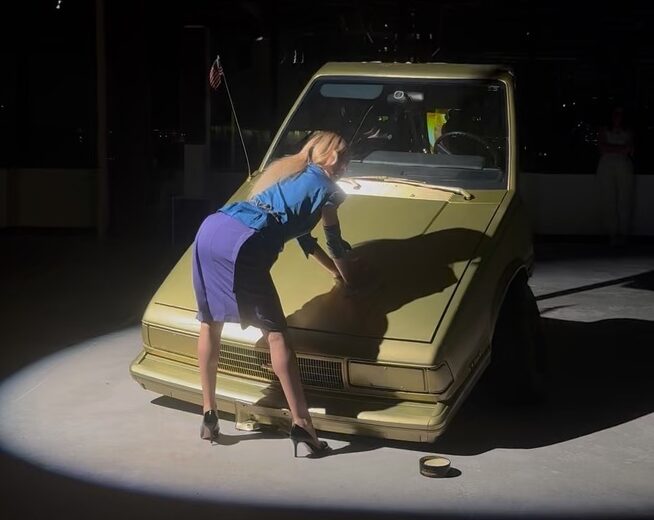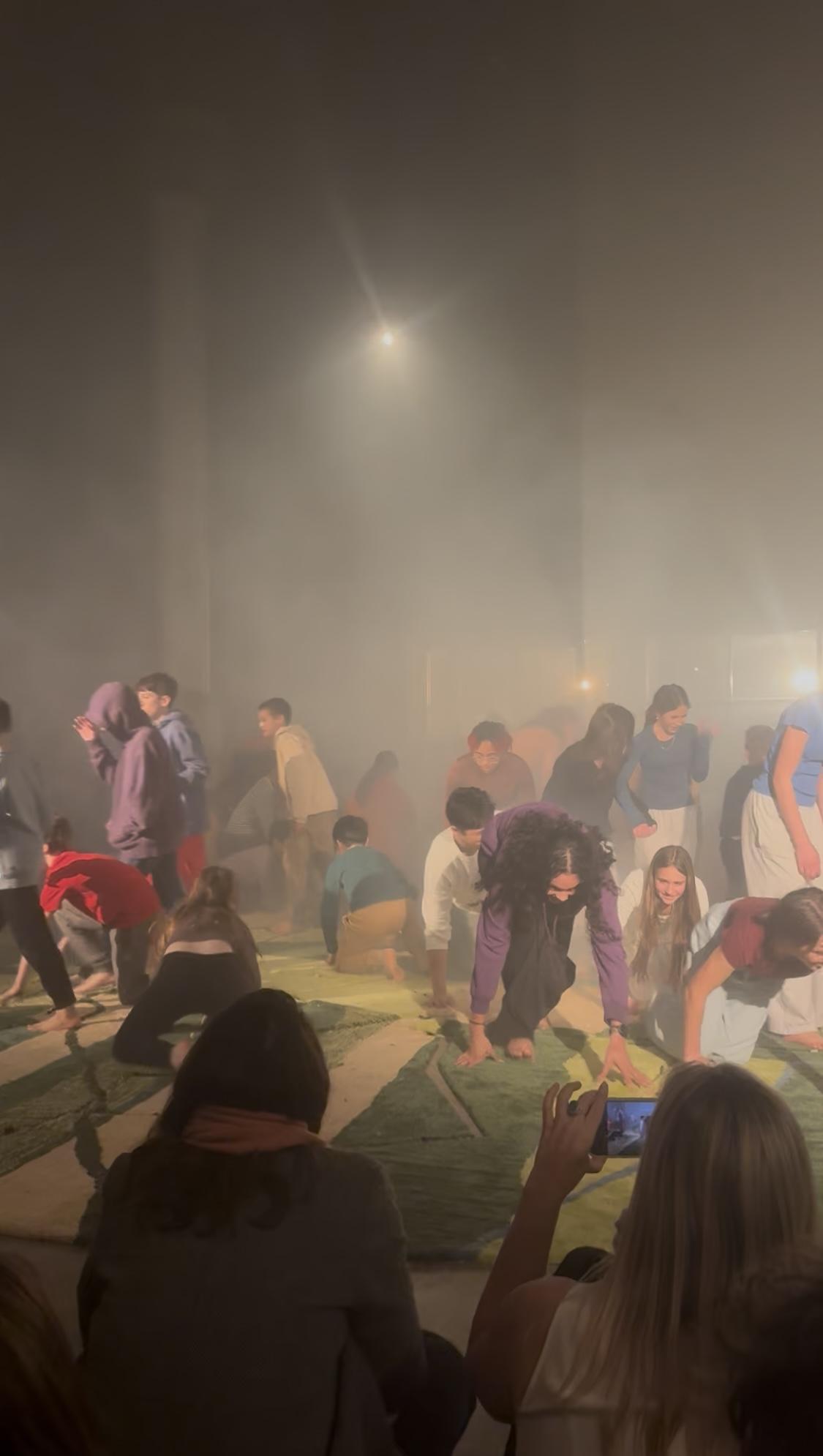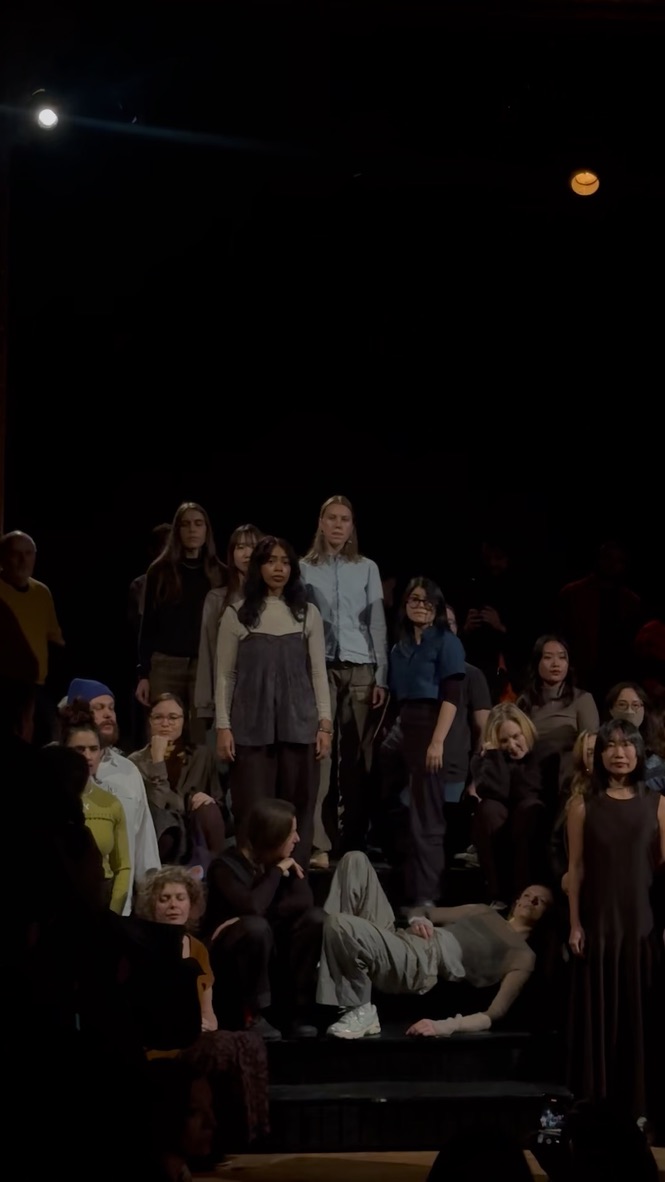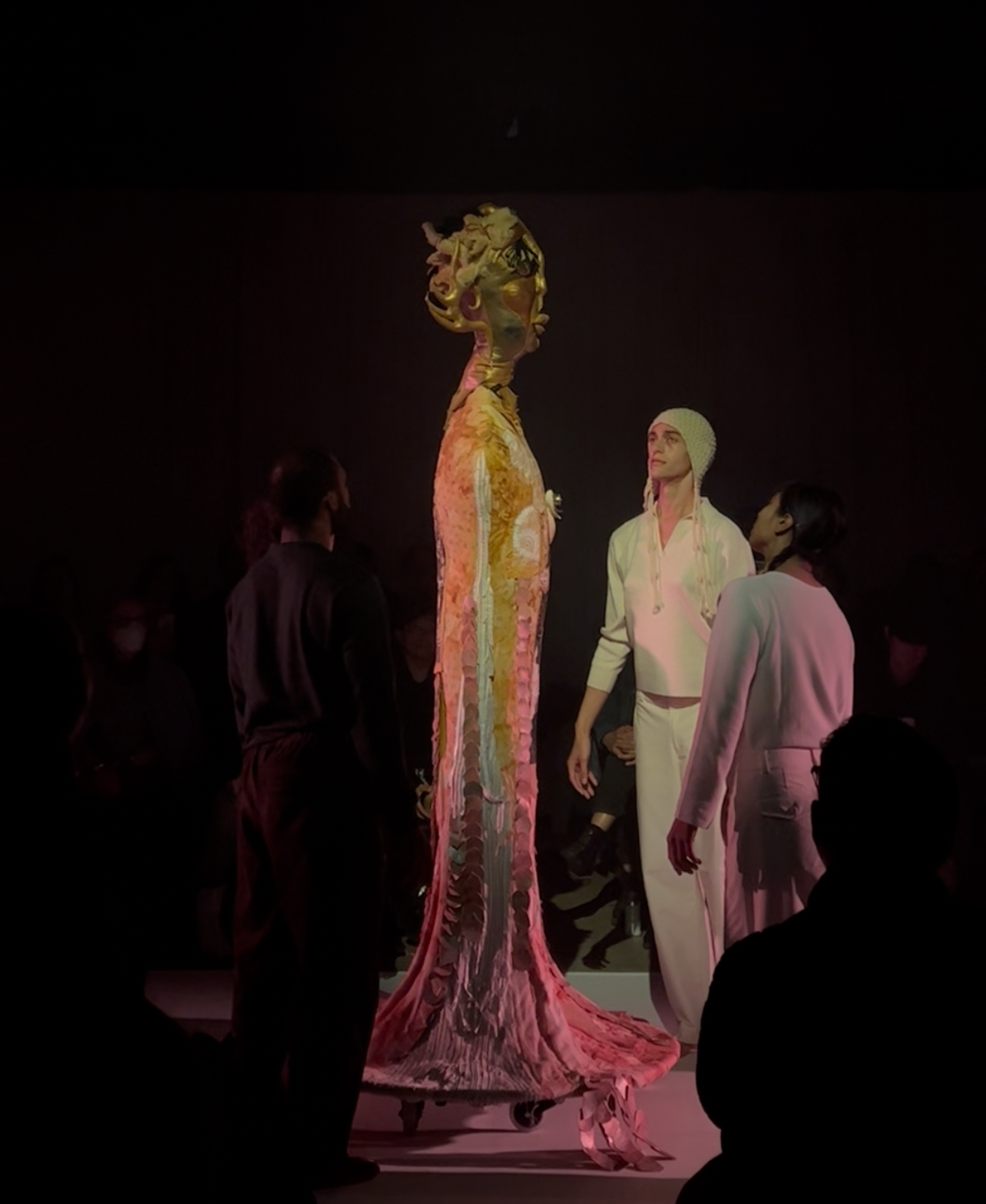Performa 2025: “What If You Went Live, What Would Happen?”


Centered, as always, around experimentation, inviting visual artists, who mostly do not work with the performance medium, to stage performances the Performa Biennial 2025 presented new pieces at venues across the city of New York, from 1–23 November. This year’s Pavilion Without Walls program spotlighted Lithuanian work; changing yearly, Performa’s pavilions explore the social, political, and artistic landscapes of different countries. “You have no idea when you get started where it’s going to end up,” the biennial’s eponymous founder, Rosalee Goldberg, says of her biennial format, where she invites artists to respond to her prompt: “What if you went live, what would happen?” Returning curators extend this ethos to stage experimental work in expected and unexpected venues.
Reporting from the front row, Qingyuan Deng, Vinh Phu Pham, and Colleen Dalusong share their thoughts on performances that tackle AI, femininity, war, Greek drama, spectatorship, and futurity by leading visual artists.
Sylvie Fleury: Spores | Performa Commission
Curated by Kathy Noble and produced by Caitlin Adams and Will Rubenstein at Water Street Projects WSA.
Sylvie Fleury’s Performa commission extends her long-standing engagement with the aesthetics of consumer culture, gender performance, and the unstable boundary between objecthood and desire. Installed in an unfinished high-rise interior, the work derives much of its force from this tension between industrial vacancy and highly stylized material forms. Fleury’s installation of objects is bookended by an eerily erotic video of muddy swamp bursting with bubbles and a spotlighted, glossy, pastel-pink rocket poised upright. Next to the rocket, a video of three intersecting mall escalators endlessly ascending loops. Seen together, they function as dialectical objects, staging a critique of the entanglements between life and death and the aspirational economies through which femininity and futurity have been historically scripted.

Dispersed in the room are heels and polished car parts. The former evokes remnants of a ritualistic shedding and the latter the absent driver. This gesture recalls Fleury’s early shopping bag installations: material signs of consumer desire emptied of content. Yet here the shoes and the incomplete cars function as tokens of gendered labor and its abandonment. Their displacement across a bare concrete floor introduces a note of historical exhaustion: gendered objects, no longer symbolizing, operate as residues of performed identity, disarticulated from the bodies that once animated them.
Glamorous performers, mostly women, reenact gestures from past Fleury performances, ranging from stroking the sleek, retro-futurist rocket sensually to humping or twerking the mid-century modernist looking car parts, while aloof, minimal electronic beats play. Recoding technological emblems and utopian iconographies of the past century through a feminized aesthetic register, Fleury stages a structural contradiction: the desire for transcendence cannot conceal the debris from the apparatuses of desire that underwrote histories of modernism and the exclusions they maintained. Fleury’s interrogating the production of value within capitalist visual regimes deploys the seductions of surface with characteristic precision. Punches after punches, the performance reveals the ideological scaffolding beneath that shine, the fantasies and failures that continue to shape contemporary spectatorship.
-Qingyuan Deng
Diane Severin Nguyen: War Songs | Performa Commission
Curated by Job Piston and Madeleine Seidel at BRIC
When do protest songs become formulaic? Is it the lyrical melodrama or rhapsodic lulling in synth-pop overlapping trill, leaving the listeners aghast and realizing we’ve heard all of this before? In Diane Severin Nguyen’s latest commission, “War Songs,” the experiment is brought to the fore with Vietnam War protest anthems remixed amongst lauded bangers of the 1980s onwards. Yes, there are the advertised nods to Bob Dylan, Joan Baez, and Peter, Paul and Mary, icons of the antiwar movement, but interspersed amongst the pantheon of early 2000s girlie-pop divas like Miley Cyrus and Hillary Duff. From Saigon to Baghdad, isn’t this “What Dreams Are Made Of”?

Hear me out–working with composer Laszlo Horvath and a band of ten energetic and marvelous performers, jamming past different eras of anti-war Americana, with elements of folk, soul, and slow-rock, the super-packed one-ish hour performance shouldn’t make sense. But if you “let ’em cook,” following the parlance du jour, and let the melodic concoction simmer. The whole thing rocks!
The throughlines are obvious–“The first televised war,” replicated by the very present camera-work and screen projections, remains as poignant as ever. At the fiftieth-year mark of the Fall of Saigon, its enduring images and sounds haunt the American consciousness. Staged against the backdrop of bandaged-like pieces of the America flag, bleeding in make-shift formation, the transition from testimonial-style monologues to choral unison leaves the audience fully captivated like an ayahuasca fever dream. This paradox of beauty and pain, how the corpse-ridden grotesque of blind faith and fanaticized political ideology could bore a whole culture of American iconography, crescendos in ironic contradiction.
The energy is earnest, eclectic, and endearingly sentimental. Peter, Paul and Miley, it’s electric Americana. It’s Woodstock, it’s Hanoi Hannah, it’s an impassioned rendition of “Em Gái Miền Tây,” à la Paris by Night. En bref, it’s thoroughly enjoyable, and undeniably timely as we maintain our global conflictive engagement, directly or indirectly, sans cesse.
– Vinh Phu Pham
Lina Lapelyte: The Speech (NYC) | Lithuanian Pavilion
Curated by Defne Ayas and Caitlin Adams, who also produced the piece, at Harlem Parish
In The Speech (NYC), composer and visual artist Lina Lapelyte gathers one hundred children and teenagers into a collective vocal experiment where language is allowed to fall apart. On tapestries and against fog machines, performers between the age of 4 and 18 run around the audience, circle the space, and lie together, improvising a pre-linguistic chorus of coos, cries, growls, and howls. None of these sounds imitates anything exactly; instead, the voices function as a kind of sonic camouflage, a chimera that acts as a stand-in for the quasi-metaphysical conviction that children are closer to ideals of nature before adults violently pull them into the social. These pre-linguistic utterances, often dismissed as trivial noise, are reframed here as the earliest forms of address, revealing how communication once moved through transcendental instinct, primordial memory, and the porousness between humans and animals.

What is profoundly moving about The Speech (NYC) is how Lapelyte manages to open up history in a former church, a space that is so defined by the structure of linguistic rituals. The rupture between children in New York City and the natural worlds that animate their fantasies for living otherwise here become parameters for waves of persistent attempts to close the widening gap between nature and culture. Through mimicry, improvisation, and guided play, the young performers summon sounds that evoke animals without reproducing the hierarchy of being, registering kinship with and estrangement from non-human other in every vocalization.
The work also critiques how children are trained into legible subjects, of correct speech and disciplined behavior. When so much of modern pedagogy reifies oppressive power dynamics, Lapelyte’s calibrated return to opacity, unpredictable unruliness, and equitable structures of being communion preserves the young performers’ freedom. Freedom is a practice and here it is a generous and generative goodbye song to language, translation, and history, against the tyranny of meaning.
-Qingyuan Deng
Pakui Hardware: Spores| Lithuanian Pavilion
Curated by Job Piston and produced by Adrienne Swan at Connelly Theater.
Pakui Hardware’s Spores is most compelling when it leans into the elemental vulnerability of the human psyche, those moments when the protagonist’s conviction in the autonomy of her selfhood cracks under the weight of longing, fear, or confusion. The choral sections, especially, carry an unexpected emotional density: their multi-voiced swell conjures a communal body, like networks of spores, a counterforce to the protagonist’s isolation, and a reminder that a healthy of state of mind is never only private, but is achieved in foraging of entangled communion. In these passages, the work reaches a moving resonance.

But when Spores turns its attention to the AI therapist (represented by a video installation in which words emerge out of the palm of a hand) its critique feels unfulfilling and undercharged. The libretto touches on alienation and the hollowness of modern living, yet it does not descend into the psychic unraveling of being reflected by a machine that only calibrates prepared answers without actual understanding. The AI’s language feels like a mellow-tempered regurgitation of therapeutic language. Perhaps this textual insufficiency exposes the deeper mismatch between human need and algorithmic response. Still, why not excavate the alienation inherent to virtual mental health care? Why not explore the unsettling experience of being, pretending to be, or not being able to be cured by AI chatbot? Why achieve resolution so easily?
This restraint becomes more noticeable because the work frames itself through the formalism of Greek drama, but the tragic structure that undergirds Greek drama is largely absent. Classical tragedy is propelled by inevitability: fate toying with the human from above, divine intervention foreclosing agency. In Spores, however, the AI never materializes that mythic pressure; it does not interject, distort, or doom, which is to say the drama lacks metaphysical intensity or stakes, when technology is well capable of creating the abyss.
-Qingyuan Deng
Tau Lewis: No one ascends from the underworld unmarked | Performa Commission
Curated by Kathy Noble
Tau Lewis’ No one ascends from the underworld unmarked is a retelling of the ancient Sumerian epic of Inanna, the queen of heaven, who descends into the underworld to visit her sister Ereshkigal, who rules over the dead. As Inanna passes through each gate of hell, she is forced to leave behind some of the jewelry and clothing that mark her as deity of status and power. By the time Inanna reaches Ereshkigal’s throne room, she is naked and powerless, and Ereshkigal kills her. Fortunately, Inanna’s disciples are able to retrieve her corpse, and Inanna is reborn as a more powerful being.

The two immortal sisters are represented by Tau Lewis’ life-size soft sculptures constructed from found objects and worn clothes, with live dancers playing the parts of Inanna and Ereshikgal’s disciples. The dancers move across the stage in a way that mirrors each sister’s temperament: Inanna’s disciples move fluidly and gracefully, whereas Ereshkigal’s disciples convulse, crawl, and snarl. In keeping with the oral tradition of reciting epic poems, Lewis collaborated with composer Lyra Pramuk and other musicians to create an otherworldly soundscape that accompanies the visual aspect of the performance. The combination of ethereal vocals and the dancers’ emotive choreography results in a transcendental experience. No one ascends from the underworld unmarked is a wonderful testament to the creativity of the human spirit, as well as an homage to the enduring wisdom that can be found in our ancient stories.
-Colleen Dalusong
You Might Also Like
A Variety Show Demanding Balls Fly at Center for Performance Research

